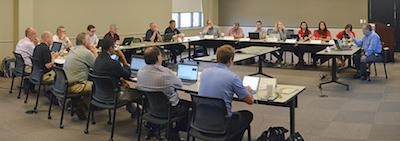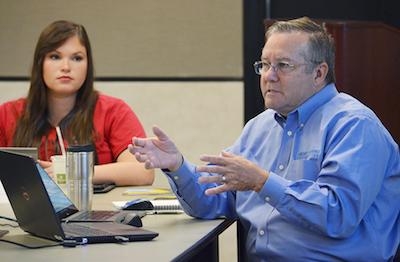Event Held At Association's Headquarters In Lee's Summit, MO
On Tuesday, Aug. 15, the Aircraft Electronics Association played host to another Quarterly Risk-based Certification Update for Manufacturers of general aviation avionics at its international headquarters in Lee's Summit, Missouri.

As an output of the February 2017 regulatory forum on NORSEE and commercial parts, the Federal Aviation Administration agreed to conduct a quarterly update on its risk-based initiatives in design, certification and production approvals. In order to assist the aviation industry in understanding these new risk-based tools available for the design, certification and production of aviation products (not limited to avionics), the AEA, in cooperation with the FAA, sponsors this recurrent, quarterly forum to allow for an open discussion on the application of this invaluable, cost-effective process.
The AEA began playing host to these quarterly forums shortly after the new product announcements took place at Sun ‘n Fun 2016. The shock-and-awe message delivered from the Experimental Aircraft Association about its “revolutionary” attitude indicator supplemental type certificate dominated the headlines during that spring event, and it was the topic of conversation throughout 2016. As industry saw in July 2017, the introduction of new products at this year’s AirVenture was a springboard to a renaissance in new general aviation products. It is certainly exciting, but there are four extremely important items that must be part of any discussion about this new paradigm, according to Ric Peri, AEA vice president of government and industry affairs.
“First, it is critical to understand these new products are not ‘experimental’ products,” Peri said. “They are Federal Aviation Administration approved and certified products. Yes, most of them are being transitioned from the experimental, amateur-built community and then being evaluated and certified (approved) for certificated aircraft. This isn’t a new process; there are hundreds of commonly installed avionics products today that got their start exactly the same way.
“Historically, most new products introduced into general aviation have received a top-down approval; that is, approval at the top-level technical standard order. There is a lot of history why this was the norm. One reason is that for the longest time, most new products originated at the highest level: military, space or commercial airlines. Extremely few products and new technologies were introduced into general aviation. It was a logical (and easy) process to develop and certify products to the TSOs. However, for the last 20 years or so, industry began to see a shift in this traditional path with the introduction of new technologies into general aviation. But the regulatory practice still drove the approval of these technologies to the highest level – a top-down approval.

“A top-down approach provides three things: a simplified, if not costly, certification process; a product with the broadest market; and easier purchasing decisions by the consumer. The bottom-up approach that is fundamental to the new paradigm does just the opposite. While it allows for the introduction of transitional products, those products are part of the continuum from EAB to classes 1 and 2 of Part 23. This does not open the market to larger and more complex aircraft. The products are designed and approved with a specific limited applicability, and it puts a lot of pressure on the consumer to know, understand and accept the intended purpose and limitations of the new products.
“This is not new. In February 2014, two years before the EAA’s STC announcement at Sun ‘n Fun, the FAA published a policy mapping the approval process for supplemental angle of attack indicators – FAA Memo No. AIR100-14-110-PM01: Approval of Non-Required Angle of Attack Indicator Systems. Many of the traditional avionics manufacturers took advantage of this policy or portions of the policy to design, certify and market AOA indicators to the general aviation community as supplemental ‘non-required’ information to enhance pilot safety by providing more and often better information than traditional stall warning systems.
“The 2014 AOA policy has migrated and mutated into the FAA’s 2016 policy on the Approval of Non-Required Safety Enhancing Equipment, or NORSEE, (Policy No. PS-AIR-21.81602). In addition, the 2009 revision to 14 CFR Part 21 set the groundwork for the scalable risk-based approach to production certificates and quality systems that many of this year’s new product entrants are utilizing. And finally, the rewrite of 14 CFR Part 23 was not effective for another month after AirVenture 2017, so not even the changes to Part 23 were the cause of these changes. In fact, the only thing to truly change was attitude and the willingness of the applicant to read the regulations, defend their rights to follow the regulations, and their willingness to produce products with limitations.
“As I stated previously, this puts a huge burden on the consumer and avionics shops to know and understand the application and limitations of the products they buy and sell. For the international consumer, many, if not all of these products, are not covered under any bilateral safety agreement, and therefore, may not be recognized as an aviation product by their civil aviation authority. If they are recognized and accepted by the international authority, you may have to develop and certify the installation without the benefit of the TSO’d data.”
(Source: AEA. Images provided)
 ANN's Daily Aero-Term (04.28.24): Airport Marking Aids
ANN's Daily Aero-Term (04.28.24): Airport Marking Aids Aero-News: Quote of the Day (04.28.24)
Aero-News: Quote of the Day (04.28.24) ANN's Daily Aero-Linx (04.28.24)
ANN's Daily Aero-Linx (04.28.24) Aero-News: Quote of the Day (04.29.24)
Aero-News: Quote of the Day (04.29.24) ANN's Daily Aero-Linx (04.29.24)
ANN's Daily Aero-Linx (04.29.24)




